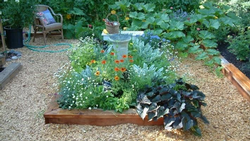Adapting Your Garden for a Changing Climate
To garden successfully as our climate changes, we must adapt our practices. Select climate-appropriate plants and then keep them healthy. Healthy plants are more resilient to climate disruptions.
Determine your baseline by documenting your garden’s characteristics.

• Add compost.
• Healthy soil holds carbon, stores water, and insulates plant roots from temperature extremes. This is key to plant health as temperatures rise and soil gets drier.
• Keep soil covered with plants or organic mulch. Not only does this help soil retain moisture and carbon, but it also reduces erosion during the rainy season.
• If your soil tends to get waterlogged during the rainy season, add compost and take other measures to improve your drainage. See Common Soil Problems.
Be fire smart. Increased wildfire threat is a sobering reality of climate change. As home gardeners, we must do our part to help our landscapes resist the spread of fire.

• Choose plants that handle our dry summers and wet winters. California natives and plants from other Mediterranean climate areas are good choices.
• Support our native pollinators and beneficial insects with your plant choices.
• Eliminate invasive plants, which outcompete our natives.
• To see what types of plants will thrive here in the future, take clues from the slightly warmer, drier climate just inland from us.

• Prepare for extremes of intense rainfall and drought. Be ready for heat waves. more frost-free days, less coastal fog, and more generations of pests each year.
• Adjust planting dates as the climate warms and climate zones shift.
• Choose varieties that are drought- and heat-tolerant.
• Choose varieties that mature quickly to get the same yields with fewer inputs.
• Rotate food crops to reduce the need for fertilizers and help prevent soil-borne disease.
• Interplant herbs and other flowering plants with food crops to attract pollinators and beneficial insects.
• Plant perennials like artichokes, asparagus, rhubarb, tree collards, berry bushes, and fruit and nut trees. Once established, their deep root systems make them less thirsty than annual crops.
• Try some of these other water-conserving tips for edible gardens.
• Grow cover crops between seasons to help soil store carbon, add nitrogen, conserve soil moisture, suppress weeds, and reduce erosion. Legume cover cops also add nitrogen to the soil.
Monitor your garden
• Observe the garden and monitor the health of your plants.
• Watch for new pathogens, pests, and invasive plants as climate change alters our garden environments.
Get Advice!
• Our Help Desk is at your service if you need help solving garden problems.
We also offer individualized Garden Walks that focus on efficient watering, healthy soil, and climate-appropriate plants for your garden.
